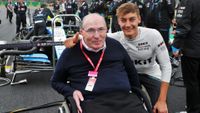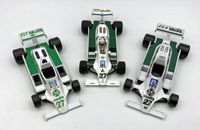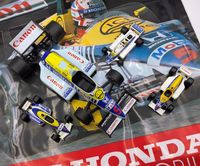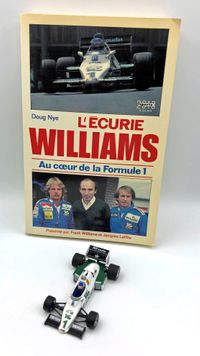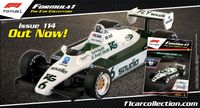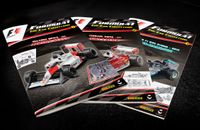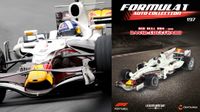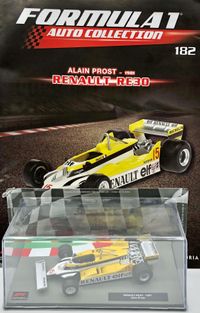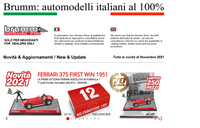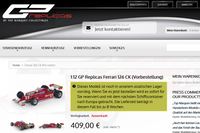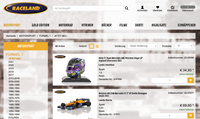Blogs 2021
Goodbye, Kimi!!!
After 349 Formula One races Kimi Räikkönen has retired. In Abu Dhabi, he said goodbye as the Grand Prix driver with the most starts. He will not be able to hold this title for long. Already next season Fernando Alonso will replace him (334 starts so far). But Kimi doesn’t matter about that. He enjoys his family and his retirement and he is glad that he no longer has to answer uncomfortable questions from journalists. Because Räikkönen did love Formula 1. But he disliked the trappings. That's why he left Formula One in 2010 for two years and became a WRC-driver. Also because he liked the environment there better.
Räikkönen will probably keep another record for all eternity. No Formula One driver of modern times has completed so few races in lower categories as the Finn. Kimi has completed a total of 23 races in Formula Renault 2.0. His 24 th car race was the Australian Grand Prix in 2001. Räikkönen never sat in a Formula 3 or Formula 2 car. He made up for his lack of experience with his talent. And so he successfully went on the points chase for Sauber in 2001. He finished sixth in the very first race. At the end of the season, he was tenth in the world championship. And together with his team-mate Nick Heidfeld, he gave Sauber its best result in the constructors' championship with fourth place.
At the end of 2001, McLaren bought him out of the Sauber contract. He drove for the British squad for five years. His first victory in Malaysia followed in 2003. In 2005, Kimi finished second in the world championship. But the big success never happened. It was not until he switched to Ferrari that his dream of a world championship title came true. With a brilliant finale (three wins from the last four races) and a one-point lead over Lewis Hamilton and Fernando Alonso (both McLaren-Mercedes), the Scandinavian secured the crown in 2007.
«Leave me alone. I know what I am doing!» f1modelcars.com
At the end of 2009, Räikkönen turned his back on Formula One and tried his hand in the WRC. The “Iceman" then returned in 2012. At Lotus, he found a different climate than before at Ferrari and McLaren. Kimi seemed to be happy and became third in the world championship. His radio message in 2012, when he was in the lead at the Abu Dhabi GP, is legendary: "Leave me alone. I know what I am doing!"
The Lotus period was followed by five years with Ferrari and three years with Sauber's successor team Alfa Romeo Racing. All in all, Kimi celebrated 21 victories, 18 pole positions and 103 podium finishes in Formula One. He was also everybody’s darling. The fans adored Räikkönen – despite his quiet and almost aloof manner. But Kimi managed something that many other Formula One drivers never achieved: He has remained authentically.
The 19 models that Kimi drove in his Formula One career have all been released in 1/43rd and 1/18th scale. However, not by one manufacturer alone. Minichamps has produced most of Kimi's cars. Spark has also followed in recent years with Räikkönen's current Alfa models. Concerning the Ferrari models that Kimi drove, you have the choice between the poorer quality models from Mattel/Hotwheels or the more expensive models from BBR or Looksmart. The latter will only have Ferrari models of Kimi from 2016 onwards. #13th December 2021
Kimi Räikkönen ist nach 349 Formel-1-Rennen abgetreten. In Abu Dhabi verabschiedete er sich als Rekord-GP-Teilnehmer. Den Titel wird er nicht lange halten können. Schon in der kommenden Saison wird ihn Fernando Alonso ablösen (bisher 334 Grands Prix). Kimi wird das ziemlich egal sein. Er geniesst Familie und Ruhestand und ist froh, dass er keine unbequemen Fragen von Journalisten mehr beantworten muss. Denn Räikkönen hat zwar die Formel 1 geliebt. Aber das Drumherum war ihm zuwider. Deshalb ist er 2010 auch für zwei Jahre in die Rallye-WM abgehauen. Dort hat ihm das Umfeld besser gefallen.
Einen Rekord wird Räikkönen wohl auf alle Ewigkeit behalten. Denn kein Formel-1-Fahrer der Neuzeit hat so wenig Rennen in unteren Formelklassen absolviert wie der Finne. Ganze 23 Rennen hat Kimi in der Formel Renault 2.0 absolviert. Sein 24. Autorennen war der Grosse Preis von Australien 2001. Räikkönen sass nie in einem Formel-3- oder Formel-2-Auto. Mangelnde Erfahrung machte er mit seinem Talent wett. Und so ging er 2001 für Sauber erfolgreich auf Punktejagd. Schon im ersten Rennen wurde er Sechster. Am Ende der Saison war er WM-Zehnter. Und gemeinsam mit seinem Teamkollegen Nick Heidfeld bescherte er Sauber mit Rang 4 das beste Ergebnis in der Konstrukteurs-Wertung.
«Leave me alone. I know what I am doing!» f1modelcars.com
Ende 2001 kaufte ihn McLaren aus dem Sauber-Vertrag heraus. Fünf Jahre fuhr er für die Silbernen. Der erste Sieg in Malaysia folgte 2003. 2005 wurde Kimi WM-Zweiter. Doch der ganz grosse Erfolg blieb aus. Erst mit dem Wechsel zu Ferrari ging der Traum vom WM-Titel in Erfüllung. Mit einem fulminanten Finale (drei Siege aus den letzten vier Rennen) und einem Punkt Vorsprung auf Lewis Hamilton und Fernando Alonso (beide McLaren-Mercedes) sicherte sich der Skandinavier 2007 die Krone.
Ende 2009 kehrte Räikkönen der Formel 1 den Rücken zu und versuchte sich als Rallye-Pilot. 2012 kehrte der «Iceman» dann zurück. Bei Lotus fand er ein anderes Klima vor als zuvor bei Ferrari und McLaren. Kimi blühte auf und wurde WM-Dritter. Sein Funkspruch 2012, als er beim GP von Abu Dhabi in Führung lag, ist legendär: «Leave me alone. I know what I am doing!»
Auf die Lotus-Zeit folgten fünf Jahre bei Ferrari und drei Jahre beim Sauber-Nachfolgeteam Alfa Romeo Racing. Unterm Strich feierte Kimi in der Formel 1 21 Siege, 18 Pole-Positions und 103 Podestplätze. Ausserdem war er der Publikumsliebling. Die Fans verehrten Räikkönen – trotz seiner stillen und unnahbaren Art. Doch Kimi hat etwas geschafft, was viele andere Formel-1-Fahrer nie erreicht haben: Er ist sich selber treu geblieben.
Die 19 Modelle, die Kimi in seiner Formel-1-Karriere fuhr, sind allesamt in 1:43 und 1:18 erschienen. Allerdings nicht bei einem Hersteller allein. Minichamps hat den Grossteil von Kimis Fahrzeugen verkleinert. Auch Spark hat in den letzten Jahren bei den aktuellen Alfa-Modellen von Räikkönen nachgezogen. Bei den Ferrari-Modellen, die Kimi fuhr, hat man die Wahl zwischen den qualitativ schlechteren Modellen von Mattel/Hotwheels oder den teureren Modellen von BBR respektive Looksmart. Wobei Letzterer erst ab 2016 Ferrari-Modelle von Kimi im Programm hat. #13. Dezember 2021
Sir Frank Williams, 1942-2021
Frank Williams was a legend. On 28th of November, the longest-serving Formula One team boss died at the age of 79. Williams had been in a wheelchair since a car accident in 1986. His loss means the end of an era for Formula One.
Williams is currently the third oldest team. Strictly speaking, the team only made its debut in 1977 under the name Williams Grand Prix Engineering. But Williams had been involved in GP racing since 1968. This was made possible by customer cars and a lot of improvisation. The often penniless Englishman from South Shields in the north of England did (almost) everything to succeed in Formula One. In the beginning, he even sold his beloved Porsche 911 just to buy his driver Piers Courage a Cosworth engine. Once he even had to win a running competition for team bosses and drivers in Monza to be able to finance the team's trip home. But as a passionate runner, he managed to do that too!
Williams made the breakthrough in 1979, when Swiss driver Clay Regazzoni celebrated the first victory at Silverstone. And team mate Alan Jones won four of the last six races. Finances were also a not entirely unimportant factor at this time. Thanks to Saudi sponsorship money, Williams had a perspective for the first time in his career as a team boss. Jones promptly secured the team's first drivers' title in 1980.
The second constructors' title followed in 1981. And in 1982 Keke Rosberg won the drivers' championship with only one victory in 15 races (!). The second golden age of Williams dawned in 1986. With Honda as engine partner, Williams won the Constructors' Championship two times in a row. And from 1992 to 1997 Sir Frank's team was the clear number 1 with Renault power. Williams wrote another successful chapter as partner of BMW (2000-2005). However, the English-Bavarian team never managed to win the world championship title during this period.
From 2006 to 2013, the team, which had become accustomed to success, had to suffer different setbacks with changing engine partners. Sir Frank and his team only emerged from this crisis when they became official partner of Mercedes. In 2014 and 2015, they finished third in the Constructors' World Championship. Since then, the traditional racing team has gone downhill. At least, Williams was able to get rid of the red lantern by finishing 8 th last season. The last victory is long time ago. In 2012, almost ten years ago, Pastor Maldonado won the Spanish GP. In total, Frank Williams' team has won 114 times. Under Sir Frank's leadership, Williams won nine constructors' titles and seven drivers' championships.
Thanks to Minichamps and Spark, (almost) the complete Williams history is available in 1:43rd scale (also before 1977). There are still a few privately entered Williams missing, such as Jo Vonlanthen's FW03 from 1975, or the '77 customer March of Arturo Merzario, Patrick Nève or Boy Hayje. But at the rate Spark is going, it will probably only be a matter of time before these gaps are also filled.
In the toy sector, the first Williams models only came onto the market as a result of the successes with Alan Jones – first and foremost with Polistil (1:43 and 1:55), Yaxon (1:43), Galgo (1:55) and Mattel/Hotwheels (1:25). Somewhat later, Bburago (in 1:24) as well as Mira (1:25), Tomica and Majorette (1:55) as well as Exoto (1:18) also offered Williams models. #28th November 2021
Frank Williams war eine Legende. Am 28. November starb der dienstälteste Formel-1-Teamchef im Alter von 79 Jahren. Seit einem Autounfall 1986 sass Williams im Rollstuhl. Sein Verlust bedeutet für die Formel 1 das Ende einer Ära.
Williams ist aktuell das drittälteste Team. Streng genommen debütierte der Rennstall erst 1977 unter dem Namen Williams Grand Prix Engineering. Doch Williams mischte schon seit 1968 im GP-Zirkus mit. Ermöglicht wurde das durch Kundenautos und sehr viel Improvisationskunst. Der oft mittellose Engländer aus South Shields im Norden Englands tat (fast) alles, um im GP-Zirkus Fuss zu fassen. Anfangs verkaufte er sogar seinen geliebten Porsche 911, nur um seinem Fahrer Piers Courage einen Cosworth-Motor zu kaufen. Einmal musste er sogar einen Wettlauf für Teamchefs und Fahrer in Monza gewinnen, um die Heimreise des Teams finanzieren zu können. Doch als leidenschaftlicher Läufer gelang ihm auch das!
Den Durchbruch schaffte Williams 1979. Als der Schweizer Clay Regazzoni in Silverstone den ersten Sieg einfuhr. Und Teamkollege Alan Jones von den letzten sechs Rennen vier gewann. Ein nicht ganz unwichtiger Faktor waren in dieser Zeit auch die Finanzen. Dank saudischen Sponsorengelder hatte Williams erstmals in seiner Karriere als Teamchef eine Perspektive. Prompt sicherte Jones dem Team 1980 den ersten Fahrertitel.
1981 folgte der zweite Konstrukteurs-Titel. Und 1982 gewann Keke Rosberg mit nur einem Sieg bei 15 Rennen (!) die Fahrer-WM. Das zweite goldene Williams-Zeitalter brach 1986 an. Mit Honda als Motorenpartner gewann Williams zwei Mal hintereinander die Konstrukteurs-Wertung. Und ab 1992 bis 1997 war das Team von Sir Frank mit Renault-Power die unumstrittene Nummer 1. Ein weiteres erfolgreiches Kapitel schrieb Williams als Partner von BMW (2000-2005). Zum WM-Titel reichte es der englisch-bayrischen Seilschaft in dieser Zeit jedoch nie.
2006 bis 2013 war das erfolgsverwöhnte Team mit immer wechselnden Motorenpartner in ein Loch gefallen. Daraus kam Sir Frank und seine Mannschaft erst wieder heraus, als man auf Mercedes-Power setzte. 2014 und 2015 belegte man den dritten Platz in der Konstrukteurs-WM. Seither geht es mit dem Traditionsrennstall bergab. Immerhin: Mit Platz 8 in der vergangenen Saison konnte Williams die rote Laterne abgeben. Der letzte Sieg liegt schon eine Weile zurück. 2012, also vor inzwischen bald zehn Jahren, gewann Pastor Maldonado den GP von Spanien. Insgesamt hat das Team von Frank Williams 114 Mal gewonnen. Unter der Leitung von Sir Frank holte Williams neun Konstrukteurs-Titel und sieben Fahrer-Meisterschaften.
Dank Minichamps und Spark ist in 1:43 (fast) die komplette Williams-Historie erhältlich (auch vor 1977). Es fehlen noch ein paar privat eingesetzte Williams wie etwa der FW03 von Jo Vonlanthen von 1975. Oder die 77er-Kunden-March von Arturo Merzario, Patrick Nève oder Boy Hayje. Aber bei dem Tempo, das Spark vorlegt, wird es vermutlich nur eine Frage der Zeit sein, bis auch diese Lücken gefüllt sind.
Im Spielzeugbereich sind die ersten Williams-Modelle erst durch die Erfolge mit Alan Jones auf den Markt gekommen – allen voran bei Polistil (1:43 und 1:55), Yaxon (1:43), Galgo (1:55) und Mattel/Hotwheels (1:25). Etwas später boten auch Bburago (in 1:24) sowie Mira (1:25), Tomica und Majorette (1:55) sowie Exoto (1:18) Williams-Modelle an. #28. November 2021
I love Kellog's Frosties
Actually, I don't collect plastic kits. Even though there are a few really nice ones. I'm thinking mainly of the Tamiya Formula 1 kits in 1:20 and 1:12, but it would definitely go beyond the scope of my already extensive collection. However sometimes I have to make an exception. This is the case with this Lotus 56B in 1:32 scale, which I recently bought on Ebay. The Lotus 56B, powered by a Pratt & Whitney turbine, is undoubtedly one of the most curious constructions in the history of Formula 1. And in the recent past it has often served as Formula 1 car for particularly detailed models – among others by Spark in 1:43 or by True Scale Models in 1:18.
It is interesting to note that the spectacular design of the car hardly caused a stir among model car manufacturers in the early seventies. I am only familiar with two miniatures. And these are two different versions of the French manufacturer Safir/Champion in 1:66. But in both cases we speak about the Lotus 56 that was raced only at Indianapolis. As far as I know, there is no «toy model» of the 56B, which in the hands of Emerson Fittipaldi achieved his best result in the 1971 Italian Grand Prix with 8th place. Except for this plastic kit – and this one was only available at Kellog's.
Kellog's? Yes, that's right. The probably best-known cereal manufacturer offered the Lotus 56B as a kit in 1973. To get the model, you had to send in six empty Kellog's Frosties packets. And fill out a coupon. In less than 28 days, so Kellog's promised, you would receive your plastic kit. However, the offer was only valid in the UK.
I cannot say anything about the accuracy of the kit. I bought the model fully assembled. But I am enthusiastic about the detail and the proportions. Nevertheless, the model has one small mistake: number 60 was never used on the Lotus 56B. Fittipaldi drove with #5, Reine Wissel with #3 (GP Silverstone) and Dave Walker with #15 (GP Zandvoort). The #60 was only used on the Lotus 56 (Indianapolis 1968). I also have to leave the question about the manufacturer unanswered. I have only found one clue. It says that the model may have been commissioned by Airfix. But I have no conclusive proof of this. #27th March 2021
Eigentlich sammle ich keine Plastikbausätze. Auch wenn es ein paar ganz schöne Exemplare gibt. Ich denke da vor allem an die Formel-1-Bausätze von Tamiya in 1:20 und 1:12. Aber es würde das eh schon umfangreiche Sammelgebiet definitiv sprengen. Hin und wieder muss ich aber eine Ausnahme machen. So etwa bei diesem Lotus 56B im Massstab 1:32, den ich kürzlich auf Ebay erstanden habe. Der von einer Pratt & Whitney-Turbine angetriebene Lotus 56B ist zweifelsohne eine der kuriosesten Konstruktionen in der Historie der Formel 1. Und in der jüngeren Vergangenheit diente sie oft als Vorbild für besonders detailtreue Miniaturen – unter anderem bei Spark in 1:43 oder bei True Scale Models in 1:18.
Interessant ist, dass die spektakuläre Keil-Konstruktion Anfang der Siebzigerjahre bei kaum einem Modellautohersteller Aufsehen erregte. Mir sind nur zwei Miniaturen geläufig. Und zwar zwei verschiedene Versionen des französischen Herstellers Safir/Champion in 1:66. Doch dabei handelt es sich um den Lotus 56, der in Indianapolis eingesetzt wurde. Vom 56B, der in den Händen von Emerson Fittipaldi 1971 beim Grossen Preis von Italien mit Rang 8 sein bestes Ergebnis erzielte, gibt es meines Wissens kein «Spielzeugmodell». Ausser eben diesem Plastikbausatz – und den gab es nur bei Kellog’s.
Kellog’s? Ja, richtig. Der wohl bekannteste Cerealienhersteller hat 1973 den Lotus 56B als Bausatz angeboten. Um das Modell zu kriegen, musste man sechs leere Kellog’s Frosties-Packungen einsenden. Und einen Coupon ausfüllen. In weniger als 28 Tagen, so versprach es Kellog’s, hat man dann seinen Plastikbausatz erhalten. Allerdings galt das Angebot nur in Grossbritannien.
Über die Passgenauigkeit des Bausatzes kann ich nichts sagen. Ich habe das Modell fertig montiert erworben. Ich bin aber von der Detailtreue und den Proportionen begeistert. Ein kleines Manko hat das Modell aber trotzdem: Die Startnummer 60 wurde beim Lotus 56B nie verwendet. Fittipaldi fuhr mit der #5, Reine Wissel mit der #3 (GP Silverstone) und Dave Walker mit der #15 (GP Zandvoort). Die #60 kam nur beim Lotus 56 (1968 in Indianapolis) zum Einsatz. Auch die Frage nach dem Hersteller muss ich unbeantwortet lassen. Ich habe nur einen Hinweis gefunden. Der besagt, dass das Modell eventuell bei Airfix in Auftrag gegeben wurde. Ich habe dafür aber keinen stichhaltigen Beweis. #27. März 2021
Formula 1 models for everyone
The Formula 1 Auto Collection in 1/43rd scale is a model series that has been available at kiosks in Italy since 2015. Each model comes with a brochure describing the car and the year in which it was used. The publisher of the «Formula 1 Auto Collection» is the Milan-based publishing house Centauria (www.centauria.it), which was founded in 1947. On its homepage, it offers a complete overview of all the models that are already in circulation and those that are yet to appear.
In the end, Centauria's F1 collection will include 230 models. Around 20 will still be released in Italy in the next few weeks. In other countries where the «Formula 1 Auto Collection» is also offered, delivery is lagging behind. In Great Britain, for example, where the F1 model cars are available at www.jasperwilliams.co.uk, only number 114 was delivered in February.
On the homepage of Centauria the models are offered for 12.49 Euros. This shows that we are not talking about models with the quality standards of Spark, Minichamps or Looksmart. The models are lowbudegt miniatures. Many of them have already been available from premium manufacturers in far better quality. Nevertheless, a few models that are available at Centauria are interesting because they have not been produced by Spark or Minichamps before. For example #182 (Renault RE30 from 1981), #185 (Osella FA1F from 1984), #187 (Toleman TG185 from 1985), #190 (Alfa Romeo 182 from 1982), #194 (Lola T93/30 from 1993) or #195 (Ferrari 312 B3 from 1973).
The fact that the models produced in Bangladesh cannot compete with premium models gets obvious when you look closer to cars from the recent past. One example is the Red Bull RB4 from 2008. Centauria offers this model in the version from the Brazil GP. It was the last race for David Coulthards in Formula 1 in a white-painted Red Bull. The original is a true work of art in terms of wings and winglets. The model of Centauria instead looks rather crude. This is less noticeable on simpler models from the seventies or eighties. The Osella by Piercarlo Ghinzani from 1984, for example, is a worthwhile purchase for the price of 12.49 Euros. By the way, decals for the missing tobacco advertising labels of the cigarette sponsor «Milde Sorte» are available on the internet (see www.facebook.com/GrandPrixDecals).
Centauria is not the first publisher to offer Formula 1 model cars as an additional source of income to books, booklets and magazines. At the beginning of the 21st century, a company called RBA in Spain (later also in Italy, France and Portugal) already produced 40 F1 models by model car manufacturer IXO according to the low-budget principle. These models were also offered at kiosks and via internet with an enclosed brochure. The complete list of all RBA models can be found under the following link: https://formula143.org/collections/rba-collection/
«I welcome the idea of Centauria.
They make Formula One accessible
to a broad mass of people!» f1modelcars.com
For collectors of high-quality model cars, the kiosk models are perhaps not necessarily recommendable. However, there is one or the other model for the discerning collector that has been missing so far and that can be pimped relatively easily with a few decals or photo-etched parts. Basically I welcome the idea of Centauria and all the other publishers. After all, they contribute to making the subject of Formula 1 (and model cars in particular) accessible to a broad mass of people. Seen in this light, the models in the «Formula 1 Auto Collection» are models for everyone. And perhaps they will trigger a real collecting virus in some people. #19th February 2021
Die Formula 1 Auto Collection in 1:43 ist eine Modellreihe, die in Italien seit 2015 an Kiosken erhältlich ist. Zu jedem Modell gibt es eine Broschüre, die das Modell und das Jahr, in dem das Auto im Einsatz stand, beschreibt. Herausgeber der «Formula 1 Auto Collection» ist der 1947 gegründete Mailänder Verlag Centauria (www.centauria.it). Dieser bietet auf seiner Homepage einen kompletten Überblick über alle Modelle, die bereits im Umlauf sind und die, die noch erscheinen werden.
Insgesamt wird die F1-Kollektion von Centauria am Ende 230 Modelle zählen. So verspricht es der Verlag. Rund 20 werden in den nächsten Wochen in Italien noch erscheinen. In anderen Ländern, in denen die «Formula 1 Auto Collection» ebenfalls angeboten wird, hinkt die Auslieferung hinterher. In Grossbritannien beispielsweise, wo die F1-Modellautos bei www.jasperwilliams.co.uk erhältlich sind, wurde im Februar erst die Nummer 114 ausgeliefert.
Bei Centauria auf der Homepage werden die Modelle für 12,49 Euro angeboten. Damit ist klar, dass wir hier nicht von Modellen mit dem Qualitätsanspruch von Spark, Minichamps oder Looksmart reden. Die Modelle sind Lowbudegt-Miniaturen. Viele davon hat es bei den Premiumherstellern in weitaus besserer Qualität bereits gegeben. Dennoch sind ein paar Modelle, die es bei Centauria gibt, interessant, weil sie bisher weder von Spark, noch von Minichamps hergestellt wurden. So zum Beispiel die Nummer 182 (Renault RE30 von 1981), die #185 (Osella FA1F von 1984), die #187 (Toleman TG185 von 1985), die #190 (Alfa Romeo 182 von 1982), die #194 (Lola T93/30 von 1993) oder die #195 (Ferrari 312 B3 von 1973).
Dass die in Bangladesch produzierten Modelle nicht mit Premiummodellen mithalten können, sieht man vor allem an Autos aus der jüngeren Vergangenheit. Ein Beispiel ist der Red Bull RB4 von 2008. Dieses Modell bietet Centauria in der Version des Brasilien-GP an, als David Coulthard in einem weiss lackierten Red Bull seinen Abschied aus der Formel 1 gab. Das Original ist ein wahres Kunstwerk an Flügel und Zusatzflügeln. Diese wirken beim Modell des Billig-Herstellers ziemlich grob. Bei «einfacheren» Modellen aus den Siebziger- oder Achtzigerjahren fällt das weniger ins Gewicht. Der Osella von Piercarlo Ghinzani aus dem Jahr 1984 beispielsweise ist für den Preis von 12,49 Euro eine lohnenswerte Anschaffung. Decals für die fehlenden Tabak-Werbeaufschriften des Zigaretten-Sponsors «Milde Sorte» gibt es übrigens im Internet (siehe www.facebook.com/GrandPrixDecals).
«Ich begrüsse die Idee von Centauria.
Sie tragen dazu bei, dass die Formel 1
einer breiten Masse zugänglich ist!» f1modelcars.com
Centauria ist nicht der erste Verlag, der Formel-1-Modellautos als zusätzliche Einnahmequelle zu Büchern, Heften und Magazinen anbietet. Anfang des 21. Jahrhunderts hat in Spanien (später auch in Italien, Frankreich und Portugal) ein Unternehmen mit dem Namen RBA bereits 40 F1-Modelle bei Modellautohersteller IXO nach dem Lowbudget-Prinzip produzieren lassen. Auch diese Modelle wurden an Kiosken und übers Internet mit einer beiliegenden Broschüre angeboten. Die komplette Liste aller RBA-Modelle gibt es unter dem folgenden Link: https://formula143.org/collections/rba-collection/
Für Sammler hochwertiger Modellautos sind die Kiosk-Modelle vielleicht nicht unbedingt empfehlenswert. Hie und da gibt es aber auch für den anspruchsvollen Sammler das eine oder andere Modell, das bisher gefehlt hat, und das man relativ einfach mit ein paar Decals oder Fotoätzteilen aufmotzen kann. Grundsätzlich begrüsse ich die Idee von Centauria und all den anderen Verlagen. Tragen diese doch dazu bei, dass das Thema Formel 1 (und Modellautos im Speziellen) einer breiten Masse zugänglich ist. So gesehen sind die Modelle der «Formula 1 Auto Collection» Modelle für jedermann. Und vielleicht lösen sie beim einen oder anderen einen echten Sammelvirus aus. #19. Februar 2021






